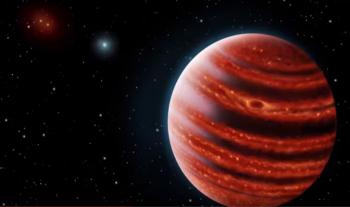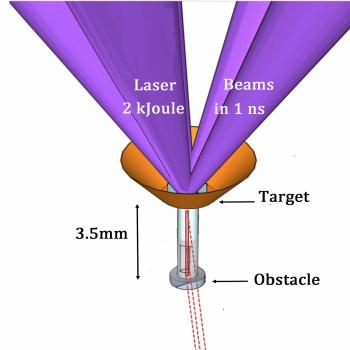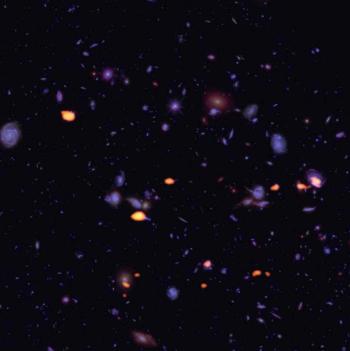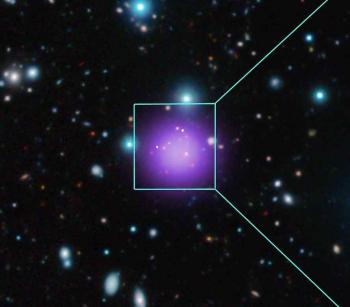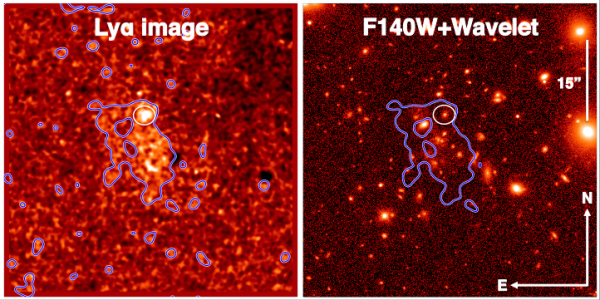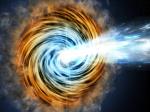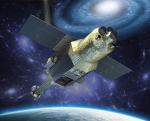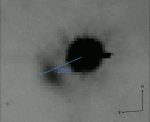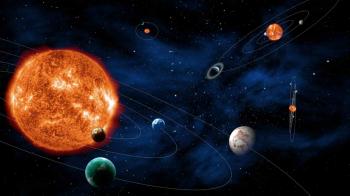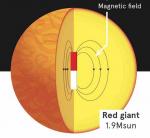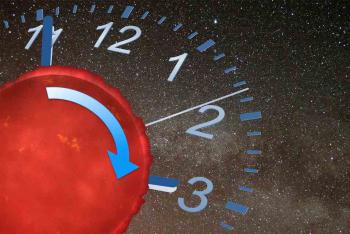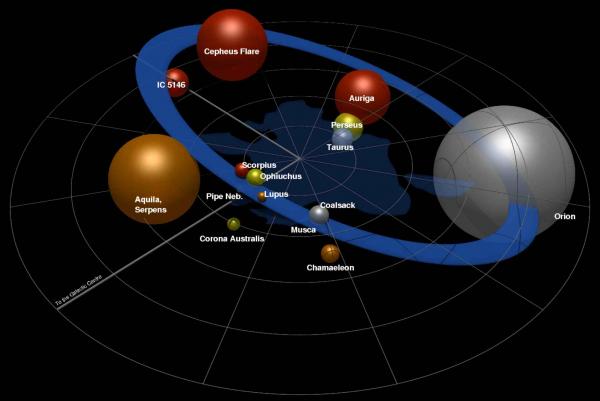News 2016
In collaboration with the Observatory of Bordeaux and the University of Bern in Switzerland, a researcher of the Astrophysics Departement-Laboratory AIM at CEA-IRFU has demonstrated the existence of significant instabilities in supersonic winds at the surface of giant planets very close to their star, described as "hot Jupiters". Using idealized 3D hydrodynamic simulations at high spatial resolution, the team showed that violent equatorial winds of the hot Jupiters are destabilized by instabilities called Kelvin-Helmholtz, well known in laboratory hydrodynamics. These instabilities cause oscillations of the wind trajectory around the equator and could be responsible for the appearance of shocks in the upper layers of the atmosphere. These phenomena may significantly affect the infrared emission and the atmospheric chemistry of these planets. These results are published in the journal Astronomy & Astrophysics
Scientists from a large international collaboration (Oxford, AWE, CEA, LULI, Observatoire de Paris, University of Michigan, University of York and STFC Rutherford Appleton Laboratory) have succeeded for the first time in generating a laboratory analogue of a strong shock that is produced when matter falls at very high speed on the surface of extremely dense stars called white dwarfs. Understanding the physics of these astrophysical objects is crucial because they are considered as the possible progenitors of thermonuclear supernovae. These supernovae are used in cosmology to measure the acceleration of the universe expansion that is linked to dark energy. To perform this spectacular astrophysics experiment, the scientists made use of the powerful Orion Laser Facility at Aldermaston (UK) to evaporate a millimetre size target and produce a hot plasma flow for an extremely short duration (less than 100 nanoseconds) [1].
Recent theoretical work has shown that, by using adapted scaling laws, this tiny size experiment can be scaled to its cosmic counterpart making it a valid replicate. Powerful lasers can therefore be used as microscopes to explore, during few nanoseconds, the high-energy radiation processes occurring in astrophysical objects from regions largely unresolved by the most powerful telescopes. The Orion experiment which is the first academic experiment on this facility, confirms that these accretion shocks, which could not be studied in laboratory a few years ago at exact scale, can now be produced commonly in laboratory. These results are published in Nature Communications, June 13th, 2016.
Observations of Malin 1, a nearby galaxy and a perfect prototype of the "giant galaxies with low surface brightness," have allowed scientists from an international team including a researcher from the Astrophysics Laboratory-Service AIM CEA-IRFU to make an unexpected discovery that challenges the assumptions about galaxy formation process of this type. It suggests that the giant disk in Malin-1, the largest known in the universe, is not the consequence of a collision but is in place for several billion years, and that stars are formed there in a modest but steady rate over the long-term. Because of their diffuse appearance and their very low gloss, these massive galaxies are difficult to observe and remain unknown today. They could be a significant fraction of the galaxies in the universe, as similar objects as Malin 1 may have escaped our vigilance.
The paper, published in Astronomy and Astrophysics, presents for the first time images of Malin 1 obtained six different wavelengths - from ultraviolet through GUViCS1 project in optical and near infrared through NGVS1 project with the camera MegaCam Canada France Hawaii Telescope, CFHT developed at the CEA [1]. Originally planned to study the Virgo cluster, these large observation campaigns also allow working on other objects in the background of this cluster, as is the case in this study.
For more information : see the French version
An international team of astronomers used the Atacama Large (Sub) Millimeter Array (ALMA) to explore the farthest part of the universe revealed by the Ultra Deep Field of the Hubble satellite (HUDF). These new observations from ALMA are significantly deeper and more resolved than previous surveys in the millimeter range. They clearly demonstrate the existence of a close relationship between the star formation rate in young galaxies and their total stellar mass. They also reveal the abundance and spatial distribution of the gas from which stars are born, providing new insight into this "Golden Age" of galactic formation dated some 10 billion years.
New observational results from ALMA will be published in a series of articles in press in the Astrophysical Journal and the Monthly Notices of the Royal Astronomical Society. They are also unveiled at the conference "Five Years ALMA : Half a Decade of ALMA: Cosmic Dawns Transformed", held this week in Palm Springs, California, USA.
For more information : see the French version
Through a unique combination of observations made by the largest telescopes in the world, an international collaboration led by researchers from the Astrophysics Department- AIM Laboratory of CEA-IRFU has detected the most distant galaxy cluster ever discovered in the Universe . Back 11.5 billion years in the past of the Universe, the snapshot of this cluster shows 17 galaxies in a strong starburst activity, a period of intense star formation. This is the first time such a structure, captured at the time of its formation, is detected as far away, when the universe was "only" 2.5 billion years. These results, achieved with the CEA skills associated in particular with the Institute for Radio Astronomy Millimeter (Iram), CNRS, and Université Paris Diderot, open a new window in our understanding about how the universe is structured in his youth . The work is published in the Astrophysical Journal on August 30th, 2016.
see more in French
An international team led by researchers from the “Service d'Astrophysique / Laboratoire AIM” of CEA-IRFU has discovered a giant nebula of ionized gas in the central region of the distant galaxy cluster CL J1449+0856. Extending over 300,000 light-years, this nebula was detected from an emission line of hydrogen, arising from a gigantic reservoir of warm gas probably ionized by two luminous quasars of the cluster. It is the first time that astronomers find in a distant galaxy cluster such a giant emission from warm gas coexisting with the hot intracluster plasma, detected with X-ray telescopes. The hot and warm gas are likely to interact, causing the evaporation of the nebula and setting its time evolution. This discovery suggests the existence of a physical connection between gas reservoirs and the first evolutionary stages of the largest bound structures of the Universe. This work is published by Francesco Valentino and his collaborators in the revue The Astrophysical Journal.
Scientists from a large international collaboration (Oxford, AWE, CEA, LULI, Observatoire de Paris, University of Michigan, University of York and STFC Rutherford Appleton Laboratory) have succeeded for the first time in generating a laboratory analogue of a strong shock that is produced when matter falls at very high speed on the surface of extremely dense stars called white dwarfs. Understanding the physics of these astrophysical objects is crucial because they are considered as the possible progenitors of thermonuclear supernovae. These supernovae are used in cosmology to measure the acceleration of the universe expansion that is linked to dark energy. To perform this spectacular astrophysics experiment, the scientists made use of the powerful Orion Laser Facility at Aldermaston (UK) to evaporate a millimetre size target and produce a hot plasma flow for an extremely short duration (less than 100 nanoseconds) [1].
Recent theoretical work has shown that, by using adapted scaling laws, this tiny size experiment can be scaled to its cosmic counterpart making it a valid replicate. Powerful lasers can therefore be used as microscopes to explore, during few nanoseconds, the high-energy radiation processes occurring in astrophysical objects from regions largely unresolved by the most powerful telescopes. The Orion experiment which is the first academic experiment on this facility, confirms that these accretion shocks, which could not be studied in laboratory a few years ago at exact scale, can now be produced commonly in laboratory. These results are published in Nature Communications, June 13th, 2016.
Analysis of the high-energy emission from the microquasar V404 Cygni has lead to the discovery of gusts of electron and positron (the electron anti-particle) plasma. This amazing discovery was possible thanks to the exquisite sensitivity of the INTEGRAL/SPI spectrometer during a strong outburst of the source in June 2015. These findings show that microquasars can be very efficient to provide significant pairs electron-positron and thus can be considered somehow as “antimatter factories”. V404 Cygni shows during this outburst several types of flares, detected at all wavelengths, some of them reaching records of brightness in the gamma-ray range. This diversity is described in a complementary study, which shows that in this binary system, high velocity matter ejections occur in form of jets. These observations highlight the key role of microquasars in the origin of the diffuse emission of electron-positron annihilation line in the galactic bulge and the still poorly known galactic gamma-ray background diffuse emission. These studies are described in two papers, the first under the leadership of a team from the Max-Planck-Institut für extraterrestrische Physik (MPE) in Garching, Germany and published in the 2016 February 29th edition of Nature, and the second lead by researchers from the Astrophysics division/laboratory AIM of CEA-Irfu and published in the revue Astronomy and Astrophysics end of 2015. In both studies, scientists from MPE and SAp joined their effort with other colleagues to analyse data from the INTEGRAL satellite, currently the unique high energy observatory allowing such findings and discoveries.
The X-ray astronomy satellite Astro-H was successfully launched on 17 February 2016 at 17H 45 (UT 8H45) from the JAXA Tanegashima Space Center in Japan. The satellite was put into orbit 14 min later and the first tests started. ASTRO-H is a JAXA / NASA mission under the Japanese leadership and with an ESA participation. This new observatory aims to observe and study the hot and energetic Universe. Astro-H embeds several instruments that when combined cover the spectral band 0.3-600 keV. Among the instruments on board, the spectrometer SXS is equipped with a state-of-the-art X-ray calorimeter. This detector, cooled to a temperature close to absolute zero, will achieve unmatched performances in terms of spectral resolution. CEA is involved in the mission, technically and scientifically, through the ESA contribution and support from the French space agency CNES.
After this sucessful launch, JAXA decided to rename Astro-H "Hitomi".
The Crab Nebula, thought for decades to be a "standard candle", has recently seen this status challenged by the observation of intense high-energy gamma rays flares. An Irish and French team (centre for Astronomy of the Université of Galway and Service d’Astrophysique from CEA–Irfu ) has stressed this finding by observing for the first time a change of polarization in visible and gamma-ray light in the central region of the nebula from 2005 to 2012. This results from a programme combining observations made at the Mount Palomar 5 meter telescope with the GASP polarimeter from the University of Galway, by the astronomical gamma-ray satellite Integral and archival data from the Hubble Space Telescope. The polarization changes could be related according to the researchers to a rearrangement process of the magnetic field and effects induced on energetic particles in a region near the central pulsar. This work is published in the journal Monthly Notices of the Royal Astronomical Society and object of the Picture Of the Month (POM) from the European Space Agency (ESA).
In a special issue of the international journal Celestial Mechanics and Dynamical Astronomy of November 2016, devoted to the study of the tidal interactions, two researchers from the University of Namur and the Astrophysics Division- AIM Laboratory of CEA-Irfu have computed the dynamics of short-period planets of different types orbiting low-mass mass stars. Their model is the first to simultaneously take into account the evolution over time of the structure and the rotation of the central star and its impact on the tidal interactions between stars and planets. They demonstrate that planets in a close orbit can be strongly influenced by changes in the structure and the rotation of the star that determine the survival or disappearance of the planet.
An international collaboration, involving the Astrophysics Department-AIM Laboratory of CEA-IRFU, managed to determine, from asteroseismology, that up to 65% of stars more massive than the Sun (between 1.6 and 2 solar masses) have a very high internal magnetic field. So far, only 5-10% of these stars were suspected to have a magnetic field up to 10 million times that of Earth. This unexpected discovery demonstrates the importance of a "dynamo effect" able of maintaining intense fields in the interior of stars. These results, obtained using the Kepler satellite data [1], are published in the journal Nature on 21 January 2016.
An international team of researchers, including the Astrophysical Department- AIM laboratory at CEA-IRFU, has established that the measure of the stellar ages derived from their rotation rate or gyrochronology must be revised for older stars that Sun. These stars are slowing less quickly than expected after a certain age, similar to that of the sun. This work is published in Nature on January 4, 2016.
Using several thousand images of Saturn's moons produced by the Cassini probe (NASA/ESA), an international team led by an astronomer from the Observatoire de Paris in the Institute of Celestial Mechanics and Calculation of Ephemerides ( Observatoire de Paris / CNRS / UPMC / Université Lille 1), in collaboration with CEA researchers, has succeeded in bringing to light small fluctuations in the gravitational field of the planet. These extremely fine results are the outcome of a series of works carried out by the same team on the Saturn ecosystem and should allow to better understand the internal structure of Saturn. These results are in press in the International Journal Icarus and are the subject of an video.
For more information : see the French version
Based on observations of nearby molecular clouds with the Herschel space observatory, recently large samples of future stars were detected in the form of dense cores. The properties of these compact seeds and their connection with interstellar filaments reveal us the earliest key stages of stars and the way of low-mass star formation.
Among several cloud complexes along the Gould Belt (see image below) the Aquila and Taurus regions were targeted. While the star formation in Aquila was relatively unexplored until recently, the Taurus cloud with its main filaments is well known. The Aquila Rift lies above the Galactic plane at the distance of about 260 parsec (approximately 850 light-years from the Sun). The Taurus region is more nearby, it seems to sit in the wall of the Local Bubble - a cavity, surrounding the Solar System- at 140 parsec (or 450 light-years) from us.
